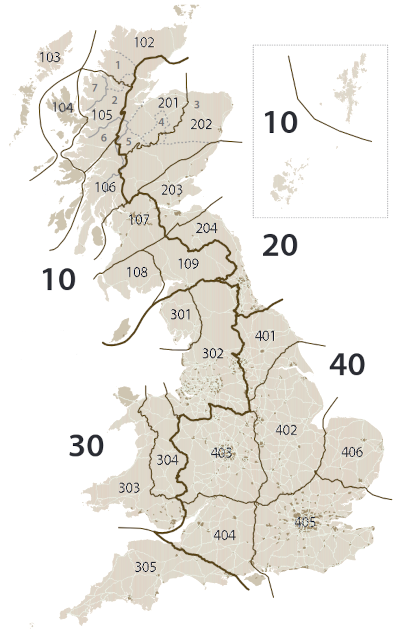British native trees have been well adapted to the British climate, altitude and their local growing conditions for over 8,000 years. Seed collected from these trees will therefore produce the most suitable progeny for planting back into that locality when compared to using plants from other parts of the UK or elsewhere in the world. For many years forestry practice has not asked enough questions regarding the source of the nursery stock being planted. Much of the stock used to plant native woodlands has come from unsuitable sources outside the UK.

The Forestry Commission has divided Great Britain into four regions of provenance; 10 & 20 in the north, and 30 & 40 in the south. These are defined areas within which similar ecological and climatic characteristics are found. They provide a basic framework for specifying sources of Forest Reproductive Material (FRM). For native species, regions of provenance have been split into 24 smaller native seed zones. Seed zones themselves are divided into two altitude bands, below and above 300 m. Figure 1 shows the main regions.
Trebrown Nurseries operates in the south-west. Therefore, where possible we source our seed from trees within provenances: UK305 and UK404. We also regularly collect certain seed in UK403. Rarely we collect seed in neighbouring provenances: UK405 in the east and UK303 and UK304 in Wales. At Trebrown we batch our plant stock based on these provenance seed-zone identity numbers and you can select your preferred planting stock from the batch identifiers. For all British natives we do not buy or collect seed from outside these regions and certainly never from abroad.
Of-course if provenance is not important to you then there is nothing stopping you planting our trees anywhere. However, note that bud-burst in the springtime occurs earlier in the south and if southern provenance trees are planted in the north, newly emergent shoots might get frost burnt. This can also have important consequences for wildlife, where food and shelter provided by the tree in the form of leaves, pollen or fruits do not develop during the time when local insects or animals require them.
Here on Trebrown Farm over the past 40 years we have been establishing our own seed stands and orchards of British native trees and shrubs. We don't yet have all the species producing seed, but we're close to producing every native species here in one place, here in south-east Cornwall, and we currently own the only registered seed stands in the whole of Cornwall. There are obvious advantages to producing our own seed: